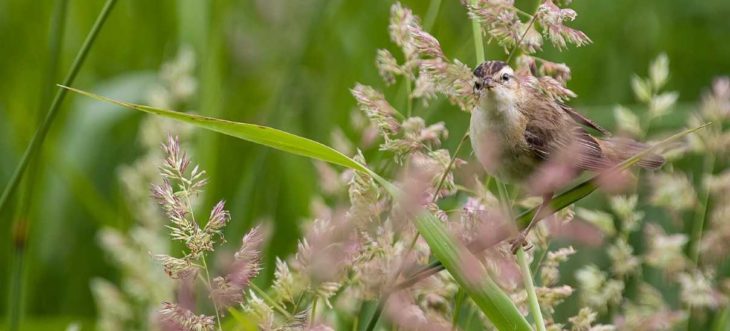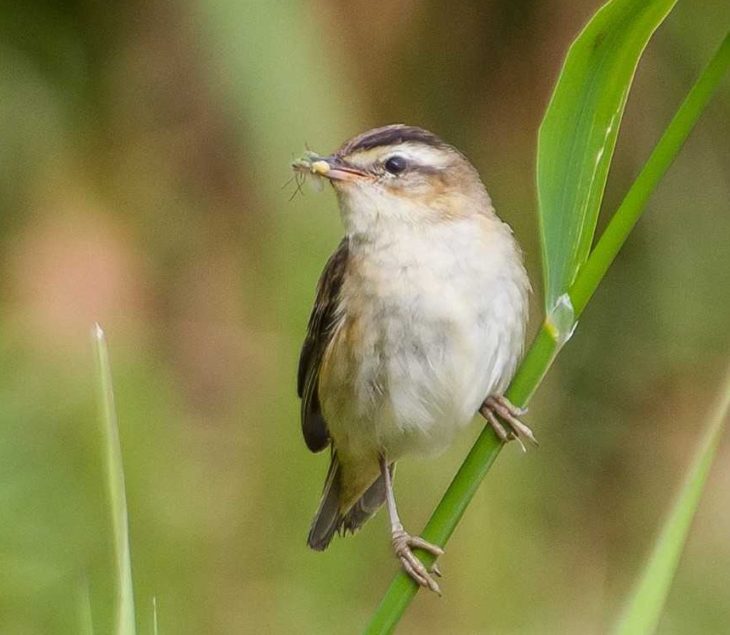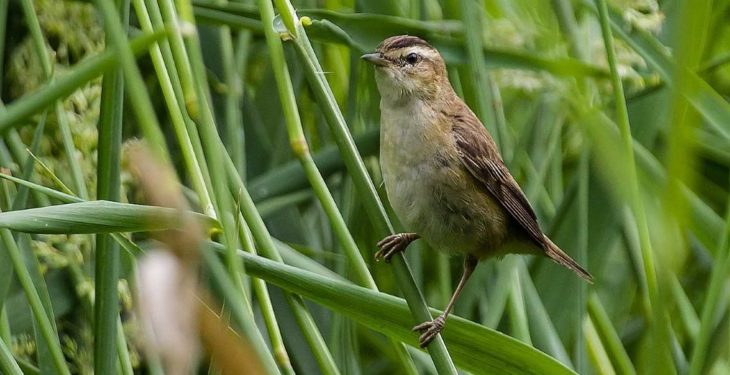Hidden in the reeds – the dramatic life of the tiny Sedge Warbler!
Montrose Basin has many warbler species. Chiffchaffs and Willow Warblers can be regularly seen in the summer at the Lurgies and the visitor centre. It’s always difficult to show them to visitors though, because as soon as you have spotted and identified them, they have snuck back into the reeds. However, in my opinion, our easiest identified warbler is the Sedge Warbler.

These small, elusive and rather skittish Warblers are attractively streaky. Both males and females are identical, with a dark striped head with a distinctive pale eye stripe and a mottled stripy brown back, on an olive-brown background. Their legs are similarly brownish-pink. They are small, between 11 ½ to 13cm long, with a wingspan of 17 to 21cm. Sedge Warblers only weigh between 10 and 13g (the same as a single AAA battery). Most live around 2 years, but the oldest was 8 years 8 months.

From April to October, Sedge Warblers can be seen in the British Isles, Europe and Asia, in a wide range of watery habitats from the Arctic Circle to mid latitudes. These have been living outside the visitor centre all summer, in our Kingfisher pond, reed beds and saltpans. Across Europe, there are between 3.1 and 4.9 million pairs, with 260,000 British pairs. Soon after arriving, the male will claim a small territory and begin to sing. Sedge Warbler songs are individual: random chattering phrases are interlaced with mimicry of other species to create a song that is never the same twice. Males with the greatest variety of melodies have greater breeding success. The song is performed theatrically whilst flying a few metres up and circling, before slowly parachuting back down. The nest is then built by the female in the reeds, just above the ground. This cup-shaped structure is weaved around the stalks and created of grass stems, spider webs, flower heads and animal hair. Up to 5 eggs are incubated for 14 days and the chicks fledge after a further 13. The females are usually monogamous, the males are less so. However, males are usually faithful to their territories, returning year after year.

Like most warblers, they are primarily insectivores. Their diet consists of a wide variety of bugs and insects; Mayflies, Dragonflies, Spiders and Beetles are all consumed. Sedge Warblers will also eat berries when fattening up for migration, though they prefer aphids. Warblers are primarily active during dawn and dusk, when it is cooler and insects are slower and easier to hunt from the reeds. Sedge Warblers prefer to feed year-round in reeds and rushes, but they can be found in shrubs, arable fields, or ditches. These birds will travel great distances for food before actually migrating in order to double their normal weight before migration.

Our Sedge Warblers will be leaving very soon. They overwinter in sub-Saharan Africa, from Senegal to Ethiopia and as far south as Namibia. Migration starts from August to September and British Sedge Warblers will fly via South Western Iberia or Italy. To cross the Sahara, birds from the south of England will travel over 2400 miles. With good winds and enough fat reserves, these birds can make this in one flight, lasting between 75 to 95 hours. Very impressive for a bird less than 13 cm long! This means that if a bird only lives the average 2 years, it will have migrated at least 9600 miles. Sedge Warblers start their return from Africa at the end of February, arriving in Europe from March.

Sedge Warblers remain least concern for conservation and are not currently threatened. However, climate change and the expansion of the Sahara may threaten them with the drying of wetlands, reducing food and adult survival; and increasing the distances between rest spots. It can be an exhaustingly long way for such a tiny bird!
Sarah Woodfin
Visitor Centre Intern
Help protect Scotland’s wildlife
Our work to save Scotland’s wildlife is made possible thanks to the generosity of our members and supporters.
Join today from just £4 a month to help protect the species you love.
Preface
Montrose Basin has many warbler species. Chiffchaffs and Willow Warblers can be regularly seen in the summer at the Lurgies and the visitor centre. It’s always difficult to show them …
